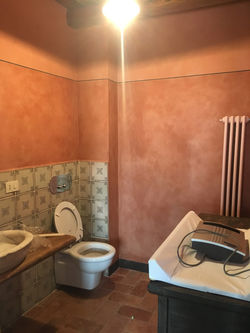Organic Colour Design
The role of the organic colour designer is designing colours with natural pigments and adhesives, with an in-depth study of the emotional aspect of colour according to the customer’s needs. Over the years, as an art contemporary’s bachelor, a lot of people met in years of work as a self-employed, I felt the need to improve my knowledge, it happened so that I approached organic painting’s world. For me was a choice based on living in harmony with nature, following the principles of safeguarding man and the planet, not dangerous for the environment and unrelated to life as synthetic products are.
What is organic painting?
In very few words we can say that they are those paints free from chemical treatments and therefore without heavy metals. Natural and vegetable pigments, clay mixtures, oxides and so on are combined with natural resins, vegetable oils, wax, starches and lime that act as glue and from this we obtain our colour. Since ancient civilizations such as Egyptians, Cretans, Romans, Greeks these materials were used to decorate palaces, houses, fabrics and ceramics. With the 19th century and the arrival of petrochemicals in industrial production, synthetic substances partially replaced the resin bases and vegetable oils, putting at risk those who work with the product and those who buy it due to the toxic vapours emitted into the atmosphere. For example, in the event of a fire, synthetic paints emit toxic gases and dense smoke that can be lethal. Usually, the most common synthetic paints can be composed of lead or xylene, ketones, phenols, epoxy resin, all elements harmful to health and the environment. Organic painting, being composed of materials deriving from nature and using normal decomposition processes, are biocompatible and biodegradable products, in a nutshell, they return to vital humus.
When can we call a natural colour?
It’s called natural when it is extracted from a quarry and pulverized or burned without chemical interventions; generally, these are called ‘natural lands’ then there are other colour categories that fall into the natural ones. For examples minerals, which may have received sweet chemical treatments that are always harmless to people and the environment, or vegetable colours obtained from the distillation of different parts of a plant: roots (madder), bark (oak), leaves (birch), stems (reseda), flowers (chamomile, saffron and coreopsis) and fruits (walnut).
You get opaque chromatic effects and light vibrations of a precious refinement. The original chromatic variations of the pigments allow the walls to breathe, resist humidity and mould.
The skills of the applicator can create high-level decorative effects with glazes and vibrant results favouring the state of well-being and defending the natural interaction with the landscape and architectural environment.
There are also many advantages of natural paints: breathability, compatibility with all substrates, maintenance, economy and sensory aspect. This last aspect invites us to love more the places we live in, the scents are varied and the tactile experiences create very interesting results.
If you have any questions, please take a look at the FAQ section, or contact me.
 |  |
|---|---|
 |  |
 |  |
 |  |
 |  |
 |  |
 |  |

